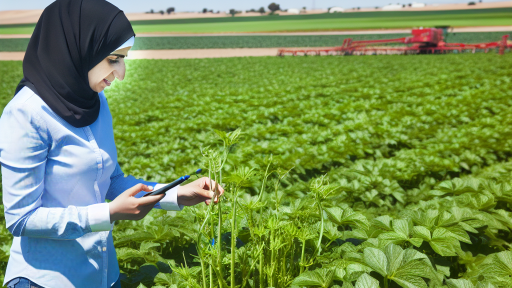Introduction to Sustainable Farming and Crop Rotation
Definition of Sustainable Farming
Sustainable farming refers to agricultural practices that prioritize ecological health.
It aims to produce food without compromising future generations’ ability to do the same.
This method encompasses various practices that enhance soil health and biodiversity.
Importance of Crop Rotation
Crop rotation is a key principle of sustainable farming.
This technique involves alternating different crops in a specific sequence.
It helps prevent soil depletion and improves crop yields over time.
Moreover, crop rotation disrupts pest and disease cycles, reducing chemical usage.
Benefits of Crop Rotation
Implementing crop rotation offers numerous advantages for farmers and the environment.
- Enhances soil fertility through diverse plant nutrient requirements.
- Reduces reliance on synthetic fertilizers and pesticides.
- Supports beneficial organisms that contribute to soil health.
Key Practices for Effective Crop Rotation
To maximize the benefits, farmers should follow best practices in crop rotation.
- Plan rotations based on crop families and nutrient needs.
- Integrate cover crops to enhance soil quality during off-seasons.
- Monitor soil health regularly to adjust practices accordingly.
Challenges in Crop Rotation
Despite its benefits, challenges may arise with crop rotation.
Some farmers resist change due to traditional practices.
Furthermore, weather variability can affect crop growth and rotation schedules.
Importance of Sustainable Farming Practices
Ultimately, sustainable farming practices, including crop rotation, are vital for our environment.
These methods provide long-term solutions for food production challenges.
By adopting sustainable techniques, we can protect our planet’s resources for future generations.
Transform Your Agribusiness
Unlock your farm's potential with expert advice tailored to your needs. Get actionable steps that drive real results.
Get StartedThe Importance of Crop Rotation in Sustainable Agriculture
Enhancing Soil Health
Crop rotation significantly improves soil health.
It naturally restores nutrients to the soil.
Planting different crops reduces soil depletion.
This practice helps in maintaining balanced soil microbiomes.
Pest and Disease Management
Crop rotation disrupts pest life cycles.
This strategy reduces the need for chemical pesticides.
By alternating crops, farmers can mitigate disease outbreaks.
For example, planting legumes after cereals can replenish soil nitrogen.
Increasing Biodiversity
Diverse cropping systems support various organisms.
This variety enhances ecosystem resilience.
Crop rotation encourages beneficial insects, which help pollination.
This ecological balance supports overall farm productivity.
Improving Crop Yields
Rotating crops can lead to higher yields over time.
Different crops benefit from differing soil properties.
Farmers experience fewer fluctuations in production.
As a result, they achieve more stable incomes.
Adapting to Climate Change
Crop rotation aids in building resilient farming systems.
This approach helps mitigate the impacts of climate change.
By diversifying crops, farmers can adapt to changing conditions.
It creates a buffer against extreme weather events.
Key Principles of Crop Rotation
Diversification Benefits
Diversification strengthens crop resilience.
It reduces the risk of pest infestations.
Additionally, varied crops support different nutrient needs.
This practice enhances farm biodiversity.
Showcase Your Farming Business
Publish your professional farming services profile on our blog for a one-time fee of $200 and reach a dedicated audience of farmers and agribusiness owners.
Publish Your ProfileSoil Health Enhancement
Healthy soils sustain higher crop yields.
Crop rotation improves soil structure and fertility.
It also helps in managing soil erosion effectively.
Moreover, rotating crops can increase soil organic matter.
Economic Advantages
Crop rotation can lead to cost savings.
It often reduces the need for chemical fertilizers.
Furthermore, diversified crops can create new market opportunities.
This approach minimizes financial risks for farmers.
Planning Effective Rotation
Planning is crucial for successful crop rotation.
Farmers should consider climate and soil types.
They must also take market demands into account.
Utilizing cover crops can be beneficial as well.
Challenges and Solutions
Farmers may face challenges in implementing crop rotation.
Inadequate knowledge can hinder effective practices.
Furthermore, financial barriers may exist.
However, training and resources can alleviate these issues.
See Related Content: Implementing Agroforestry for Farm Diversity
Best Practices for Implementing Crop Rotation in Farming
Understanding Crop Rotation
Crop rotation is a vital practice in sustainable farming.
This method involves alternating the types of crops grown in a specific area.
It helps in breaking pest and disease cycles.
Additionally, it improves soil health and fertility.
Planning Your Rotation
Effective crop rotation starts with careful planning.
First, identify the crops suitable for your region.
Then, consider their nutrient requirements and growth patterns.
Using a rotation plan helps maintain balance in soil nutrients.
Establishing a Rotation Schedule
Creating a rotation schedule is essential for success.
Map out which crops will be planted each season.
Incorporate deep-rooted crops to help break up compacted soil.
Moreover, rotate between legumes and non-legumes to enrich nitrogen levels.
Maintaining Diversity
Diversity is crucial in a crop rotation strategy.
Rotate different families of crops to prevent soil depletion.
This practice enhances soil structure and biodiversity.
Integrating cover crops can also improve soil health further.
Monitoring and Adjusting
Regular monitoring is vital to assess soil health.
Evaluate crop yields and soil quality after each rotation cycle.
Adjust your rotation plan based on these assessments.
This flexibility allows you to respond to changing conditions.
Incorporating Livestock
Including livestock in the rotation can be beneficial.
They help in managing weeds and pests effectively.
Manure from livestock enhances soil fertility significantly.
Showcase Your Farming Business
Publish your professional farming services profile on our blog for a one-time fee of $200 and reach a dedicated audience of farmers and agribusiness owners.
Publish Your ProfileHowever, ensure you manage livestock impacts on the land carefully.
Educating Yourself and Others
Continuous education on agronomic practices is essential.
Attend workshops and seminars to stay informed.
Share your experiences and knowledge with fellow farmers.
Networking can lead to shared resources and strategies.
Discover More: Nutrient Cycling For Soil Health Improvement
Choosing the Right Crops for Effective Rotation
Understanding Crop Diversity
Crop diversity enhances soil fertility and structure.
It reduces the risk of pest and disease outbreaks.
Furthermore, it allows for better use of available nutrients.
Selecting Complementary Crops
Choose crops that complement each other.
Legumes are excellent for nitrogen fixation.
Consider pairing legumes with nutrient-demanding plants.
For example, intersperse peas with corn to improve yields.
Identifying Seasonal Growth Patterns
Match crop types to their growing seasons.
Cool-season crops thrive in early spring and autumn.
Warm-season crops flourish during summer months.
This strategy maximizes harvests throughout the year.
Assessing Soil Health and Conditions
Test soil composition before selecting crops.
Some crops prefer sandy soil, while others thrive in clay.
Choose crops suited to your soil type for better growth.
Also, analyze soil pH levels to ensure crop compatibility.
Considering Local Climate Factors
Climate plays a significant role in crop selection.
Research local weather patterns and historical data.
Adapt your choices based on potential climate changes.
This foresight will lead to more resilient farming practices.
Utilizing Crop Rotation Plans
Create specific rotation plans tailored to your farm.
Include various crops to maximize benefits across seasons.
Rotate crops to mitigate soil nutrient depletion.
Maintain thorough records of crop performance and soil conditions.
Gain More Insights: Integrating Hydroponics for Water-Efficient Farming

Impact of Crop Rotation on Pest and Disease Management
Understanding Pest Dynamics
Crop rotation alters the pest dynamics in agricultural systems.
This method reduces pest populations over time.
It disrupts the life cycles of harmful insects.
As a result, fewer pests lead to better crop yields.
Beneficial Insects and Biodiversity
Crop rotation encourages beneficial insects to thrive.
These insects help control harmful pest populations naturally.
Furthermore, biodiversity increases soil health and resilience.
A diverse ecosystem promotes natural pest control.
Disease Suppression
Planting different crops prevents the buildup of diseases.
Many soilborne pathogens thrive on specific crops.
Showcase Your Farming Business
Publish your professional farming services profile on our blog for a one-time fee of $200 and reach a dedicated audience of farmers and agribusiness owners.
Publish Your ProfileSwitching crops disrupts the host availability for pathogens.
Additionally, certain crops can outcompete or inhibit pathogens.
Integrated Pest Management Strategies
Crop rotation fits well into integrated pest management (IPM) strategies.
IPM focuses on long-term prevention and ecological balance.
Using rotation as a tactic reduces reliance on chemical controls.
This approach fosters healthier crop systems and environments.
Practical Implementation
Farmers should develop a rotation plan tailored to their crops.
Key factors include soil type, climate, and local pests.
Planning ensures compatibility among rotation crops.
A well-executed rotation can lead to sustainable farming success.
Uncover the Details: Water Management Techniques For Healthy Soil
Evaluating Soil Nutrient Dynamics through Crop Rotation
Understanding Soil Nutrients
Soil nutrients are essential for plant growth.
They influence crop yield and quality significantly.
Key nutrients include nitrogen, phosphorus, and potassium.
Each of these plays a unique role in plant health.
Consequently, monitoring soil nutrient levels is vital.
The Role of Crop Rotation
Crop rotation enhances soil nutrient dynamics effectively.
By alternating different crops, farmers can replenish nutrients.
Certain crops fix nitrogen, benefiting subsequent plants.
For instance, legumes add nitrogen back into the soil.
This practice minimizes the depletion of soil nutrients.
Identifying Nutrient Needs
It is crucial to assess soil nutrient levels regularly.
Soil tests can inform farmers about nutrient deficiencies.
These tests provide crucial data for management decisions.
Farmers can tailor their crop rotation strategies accordingly.
Using this data enhances crop performance and sustainability.
Implementing Best Practices
Adopting best practices improves soil health and fertility.
Different crops should be planted in successive seasons.
For example, rotating corn with soybeans helps balance nutrients.
Cover crops also play a significant role in soil recovery.
They protect soil during off-seasons and enrich it with organic matter.
Monitoring and Adjusting Strategies
Continuous monitoring is essential for optimizing crop rotation.
Farmers should analyze the performance of rotated crops.
This analysis reveals how well the crops utilize soil nutrients.
Adjustments can be made based on the findings.
Implementing these changes leads to more resilient farming systems.
Case Studies: Successful Crop Rotation Strategies from Around the World
Australia: Sustainable Practices in Wheat Farming
In Australia, farmers like Sarah Thompson have adopted effective crop rotation methods.
They alternate between wheat and legumes to improve soil health.
This practice enhances nitrogen fixation and boosts crop yields.
Moreover, it helps in reducing pests and disease prevalence.
Showcase Your Farming Business
Publish your professional farming services profile on our blog for a one-time fee of $200 and reach a dedicated audience of farmers and agribusiness owners.
Publish Your ProfileUnited States: Diversifying Crops for Resilience
The Johnson family farm in Iowa focuses on crop diversity.
They rotate corn, soybeans, and cover crops annually.
This approach enhances soil structure and fertility.
Consequently, it reduces the reliance on chemical fertilizers.
Netherlands: Innovative Farming Systems
Farmers in the Netherlands, like Jan de Vries, implement advanced crop rotation systems.
They combine vegetable and flower crops in their planning.
This not only maximizes land use but also minimizes pest outbreaks.
Furthermore, it leads to higher economic returns.
Brazil: Integration of Livestock and Crop Production
In Brazil, Luiz Oliveira practices integrated crop-livestock systems.
This method involves rotating cattle grazing with soybean cultivation.
This strategy enhances nutrient cycling and soil health.
Ultimately, it supports sustainable land use and boosts profitability.
Germany: Enhancing Biodiversity through Rotation
German farmers utilize a diverse range of crops in their rotations.
This includes grain, legumes, and root vegetables.
Such practices improve ecosystem services and increase resilience.
Additionally, they are contributing to the overall health of farmland.




